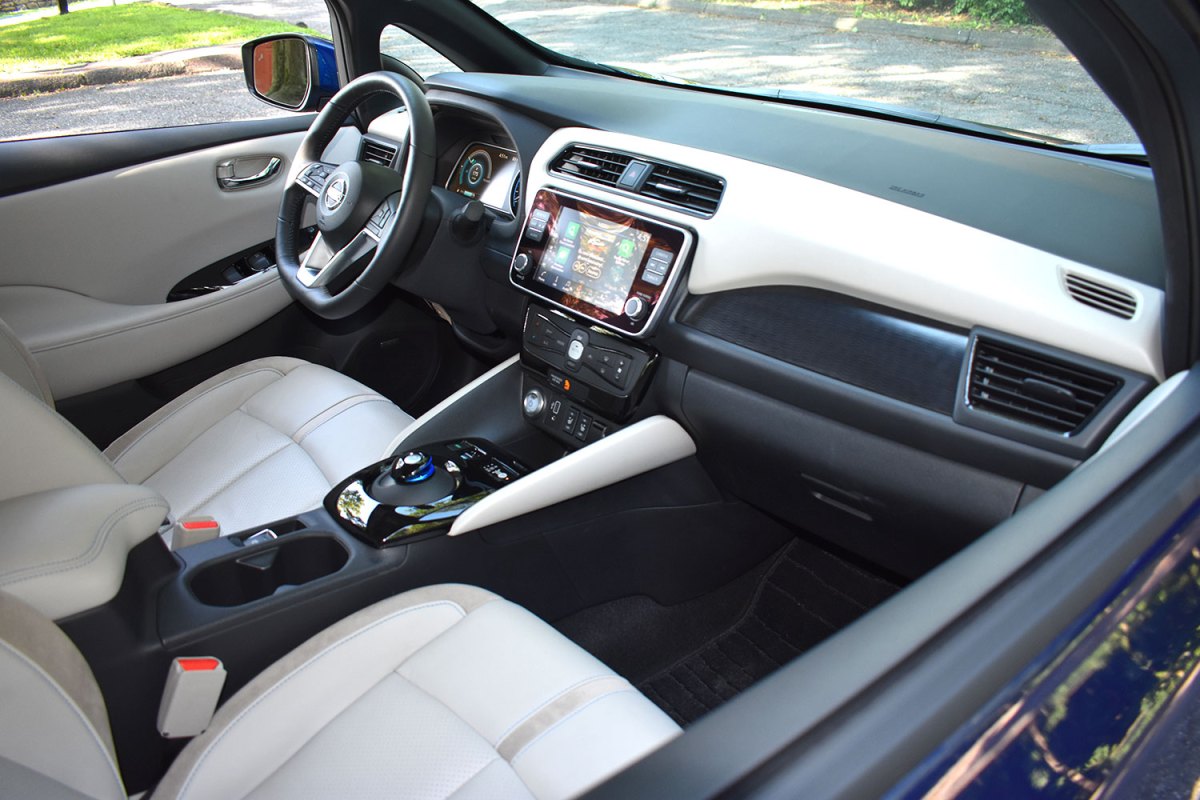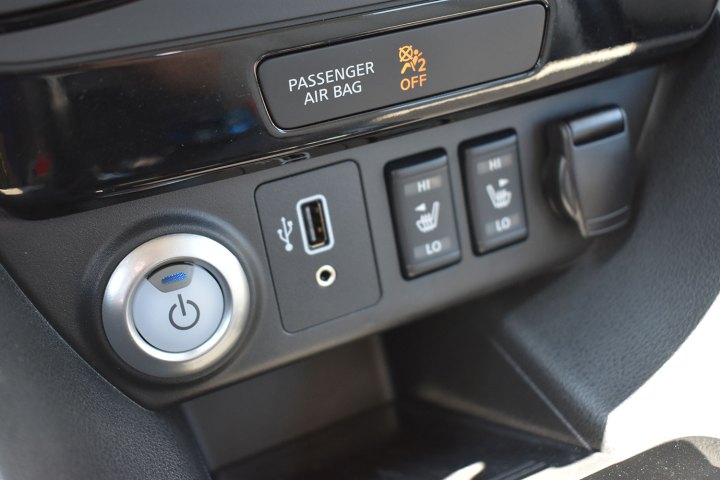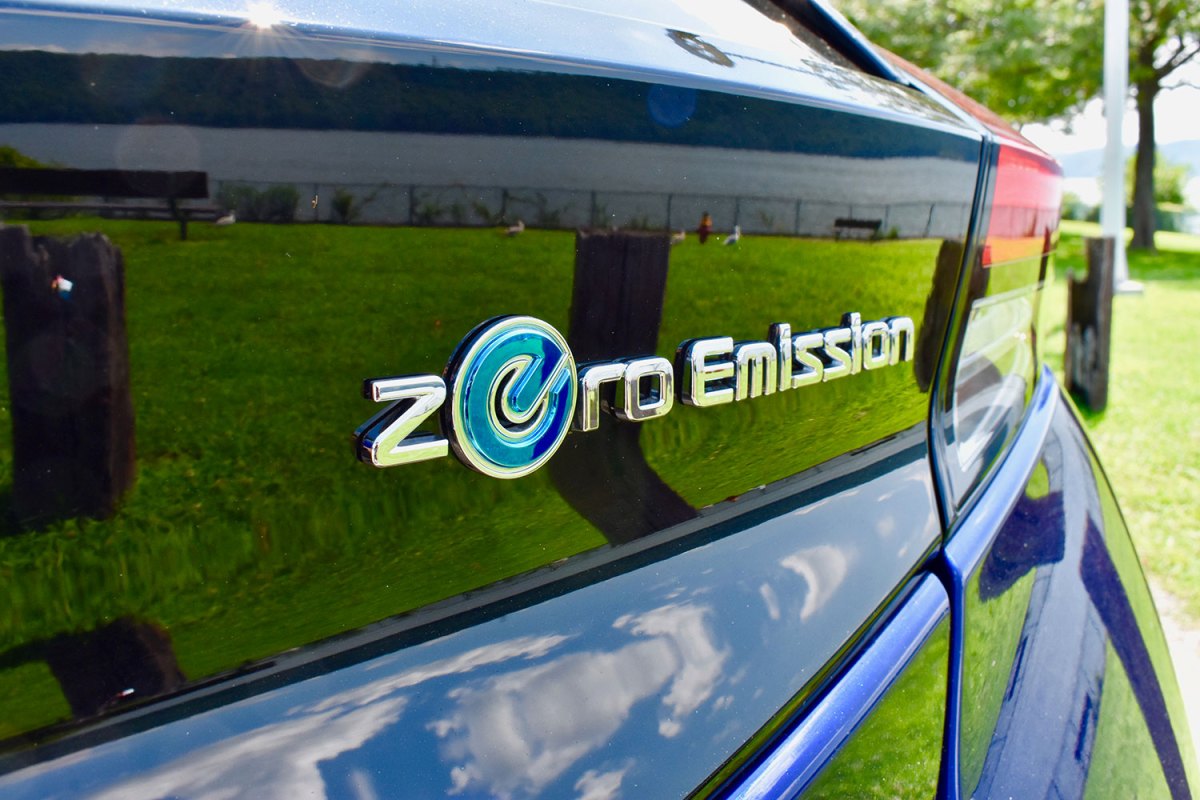- Improved range
- Punchy powertrain
- Spacious interior
- Clever e-Pedal system
- Poor suspension tuning
- Cheap-looking interior
- Hard to see the point of ProPilot Assist
The Nissan Leaf was the first modern electric car to be manufactured and sold in large numbers, and has gone on to become the bestselling electric car in history. But Nissan is now playing catch-up.
It’s not possible to buy an electric car with over 200 miles of range for under $40,000, but when the second-generation Leaf launched in 2017, it could only muster an EPA-rated 150 miles of range. Enter the 2019 Nissan Leaf Plus. Thanks to a larger battery pack, this new model has up to 226 miles of range. It’s got more power than the standard Leaf, too. But it’s also more expensive.
The 2019 Nissan Leaf Plus starts at $37,445 – a $6,560 premium over the standard-range Leaf (all prices include a mandatory $895 destination charge). Our test car was also a range-topping SL model, which rang up at $43,920. The SL includes extras like leather seats, LED headlights, and Nissan’s ProPilot Assist driver aid, but also comes with a range penalty. Both the SL and the mid-range SV are rated at 215 miles of range; only the base S trim level achieves the maximum 226 miles.
Blending in
Nissan did a complete 180 with the styling of the current-generation Leaf. Where the first-generation Leaf advertised its electric powertrain with sci-fi styling, its successor looks like an ordinary hatchback. Styling cues, including the “V-Motion” grille and “floating” roof line, are borrowed from other current Nissan models. As with the first-generation Leaf, the charge port is housed in the nose of the car. But this time it’s discreetly hidden between the grille and hood seam. Visually, the Plus model is indistinguishable from the standard-range Leaf, with only discreet badging to show that you’ve splurged for the extra range.

The interior also carries over from the standard-range Leaf. Most of it is standard Nissan fare, meaning a rather sensible design let down by cheap-looking materials. The overall commonality with other Nissan models makes the Leaf feel reassuringly normal, until you go to put it into drive. In place of a conventional lever, you get a circular device that you need to slide around like a computer mouse to select drive or reverse (park is a button on top). The shifter carries over from the first-generation Leaf, but its form-over-function design seems more out of place in the more conservatively-styled second-generation model.
Like the standard-range Leaf, the Plus has an unusually tall driving position that we found to be a bit awkward. That, along with the steering column’s lack of adjustability (it tilts but doesn’t telescope) made it hard to find a good driving position. The front seats are pretty comfortable, though, and the car offers good outward visibility (supplemented by a 360-degree camera system on our test car) despite a steeply-raked windshield and thick rear pillars.
The Leaf is likely the most practical electric car most buyers will be able to get their hands on.
The Leaf Plus comes standard with an 8.0-inch central touchscreen display, but you have to upgrade from the base S trim level to the SV to get Apple CarPlay and Android Auto. The infotainment system doesn’t have a lot of bells and whistles, but at least it’s easy to find a SiriusXM station. We also liked the layout of the digital instrument cluster display, which featured bold, simple graphics that conveyed information easily.
The Leaf is likely the most practical electric car most buyers will be able to get their hands on. The Chevrolet Bolt EV and BMW i3 are both smaller hatchbacks, while the Tesla Model 3 is a sedan, with a trunk instead of a rear hatch. Many other electric cars, including the Kia Niro EV, Volkswagen e-Golf, and Hyundai’s Ioniq Electric and Kona Electric, aren’t available nationwide.

If you don’t live in a state where those cars are available, you aren’t missing too much when it comes to passenger and cargo room. The Leaf is near the top of the group on passenger space, and offers more cargo space than even the tall-roofed Kia Niro EV with its rear seats in place. However, cargo space doesn’t dramatically improve with the rear seats folded, as it does in most other electric hatchbacks.
More range, more power
The Leaf Plus gets its extra range thanks to a bigger battery pack – 62 kilowatt-hours, compared to 40 kWh for the standard Leaf – but that’s not the only thing Nissan upgraded. The Plus also has more power. Its 214 horsepower and 250 pound-feet of torque are increases of 67 hp and 14 lb-ft over the standard-range Leaf.
Zipping through traffic will put a smile on your face.
You can feel the extra power from behind the wheel. Where the standard-range Leaf felt pretty gutless beyond initial throttle tip-in, the Leaf Plus accelerates forcefully up to highway speeds. That adds something that was previously missing from the driving experience: fun. Zipping through traffic will put a smile on your face. But the Leaf still isn’t a fast car. Nissan didn’t provide any acceleration numbers, but we’d be surprised if the Leaf Plus could match the manufacturer-estimated 5.3-second zero to 60 mph time of a base Tesla Model 3.
We also wish Nissan had also upgraded the suspension when they fettled the powertrain. As with the standard-range Leaf, the Plus model had the body roll of a 1970s Lincoln Continental in corners, but without the cushy ride to match. Again, the Tesla Model 3 outclasses the Nissan here, but so does the Chevrolet Bolt EV. The Chevy feels more nimble, adding to the fun factor. While it has less horsepower (200 hp) than the Leaf Plus, the Bolt EV has more torque (266 lb-ft) and weighs less.

The Leaf Plus does have one trick its rivals can’t match. Now every electric car has regenerative braking, which harvests energy from deceleration to recharge the battery pack. It means you slow down a bit just by letting off the accelerator pedal, similar to engine braking in an internal-combustion car. Nissan took things a step further with e-Pedal. This standard feature combines regenerative braking with the car’s conventional friction brakes, so you almost never need to touch the brake pedal. The system will slow the Leaf to a complete stop if you let it. This works great in stop and go traffic, and takes the guesswork out of when to rely on to rely on regenerative brakes, and when not to. If it you don’t like it, you can always turn it off.
Nissan is my co-pilot
Our test car was equipped with Nissan’s ProPilot Assist system. It’s similar in concept to Tesla’s Autopilot or Cadillac’s Super Cruise, allowing the car to accelerate, brake, and stay centered in its lane on highways while the driver keeps a watchful eye on the tech. Unlike Autopilot, ProPilot Assist can’t execute lane changes; flicking the turn-signal stalk deactivates the system until the driver has completed the maneuver. ProPilot Assist is more sophisticated than any driver aids offered in other non-Tesla electric cars, but that doesn’t mean much in the real world.
Nissan designed ProPilot Assist to work on highways with clear lane markings, clear weather, and an attentive driver. Under those conditions, it works well. Acceleration, deceleration, and steering input are smooth. The system also responded quickly when getting cut off by other cars, a frequent occurrence if you drive at the speed limit anywhere within 50 miles of New York City, as we were. However, we did find some curves on our test section of highway that were too sharp for the system. ProPilot Assist didn’t apply enough steering angle, sending the car coasting over the white lines.
Situations like that highlight that ProPilot Assist should not be confused with autonomous driving. It basically adds lane centering on top of adaptive cruise control, and taking your hands off the wheel for even a few seconds will trigger a warning to pay attention. Even with ProPilot Assist working, we found few opportunities to relax even in moderate traffic. There was simply too much going on, requiring frequent interventions to avoid merging traffic, slower cars, and other potentially troublesome situations. We didn’t feel that ProPilot Assist was appreciably lightening the workload. It’s best to think of ProPilot Assist as a very sophisticated cruise control system: good for long stretches of straight-line highway driving, but not much help anywhere else.
The practical stuff
Range is why the Leaf Plus exists. The standard Leaf’s EPA-rated 150-mile range was no longer adequate once you could buy a 238-mile Chevy Bolt EV (the Chevy is expected to achieve 259 miles for 2020) or 240-mile Tesla Model 3 for slightly more money. The Hyundai Kona Electric offers 258 miles of range, while the Kia Niro EV is rated 239 miles, but neither car is available nationwide (a Kia Soul EV with 243 miles of range is launching soon as well). The EPA-rated 226-mile range for the Leaf S Plus and 215-mile range for the Leaf SV and SL Plus may not be class-leading, but it puts Nissan’s electric car back into contention.
The Leaf had the body roll of a 1970s Lincoln Continental in corners, but without the cushy ride to match.
The Leaf’s range deficit might not even be an issue if Nissan equipped the Leaf with a more powerful charger. When connected to a 240-volt Level 2 AC source, the standard 6.6-kilowatt unit can recharge the battery pack in 11.5 hours, according to Nissan. Some competitors offer more powerful chargers that can recharge a similarly-sized battery pack in around 9.5 hours. Nissan did make DC fast-charging standard on the Leaf Plus, allowing for an 80-percent charge in 45 minutes. Nissan has worked with third-party companies for years to build up a network of fast-charging stations, but coverage may vary depending on your area.
The Leaf Plus also comes standard with autonomous emergency braking, but you have to upgrade from the base S trim level to the SV to get adaptive cruise control. ProPilot Assist, a 360-degree camera system, blind spot monitoring, rear cross traffic alert, and a driver-alertness monitor are included in the top SL trim level.
Nissan offers a three-year, 36,000-mile, basic warranty and five-year, 60,000-mile, powertrain warranty. The Leaf received an average reliability rating from Consumer Reports. As with all electric cars, routine maintenance costs should be lower than an internal-combustion car due to the smaller number of parts.

The Leaf Plus received top “good” scores in Insurance Institute for Highway Safety (IIHS) crash tests, but the IIHS has not published its typical headlight and front-crash prevention ratings for the car. The National Highway Traffic Safety Administration (NHTSA) hasn’t given any current-generation Leaf model a star rating for crash tests.
How DT would configure this car
This is a tough one. The base S trim level is the only one to achieve the Leaf Plus’ headline 226-mile range, but it’s missing crucial tech items, specifically Apple CarPlay/Android Auto and adaptive cruise control. So we would sacrifice 11 miles of range and spend an extra $1,960 to get the SV trim level, which adds those features. That’s as far as we would go, though.
The top SL trim level adds more driver aids, as well as leather seats and an upgraded audio system, but we don’t think they make the car better. ProPilot Assist doesn’t have enough real-world utility to be worth the extra money, and our test car’s interior didn’t feel worthy of its sticker price. The Leaf’s greatest asset is value, so it pays to choose options carefully.
Summary
It’s easy to dismiss the 2019 Nissan Leaf Plus as too little, too late. Nissan lost the lead in electric cars, and its best effort can’t even beat rival cars in range. But that’s not the whole story. With 258 miles of range and one of the best small-vehicle chassis currently available, the Hyundai Kona Electric should be a threat to the Leaf. But the Hyundai is only available in California.
The Tesla Model 3 and Chevrolet Bolt EV are both available nationwide, and both offer more range than the Leaf Plus. But the Nissan offers more cargo space than the Tesla, doesn’t ask buyers to adjust to an unfamiliar interface, and doesn’t come with any uncertainty about when you will get your car. The Bolt EV is more fun to drive, but also has less cargo space than the Leaf, and its exterior styling isn’t for people who want to blend in.
Should you get one?
Yes. The 2019 Nissan Leaf Plus is great for anyone who wants an electric car that feels like a normal car.




